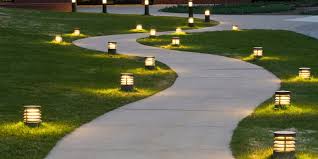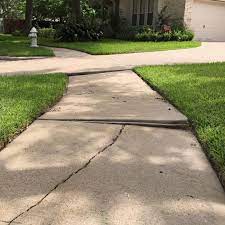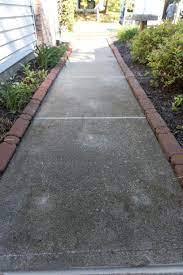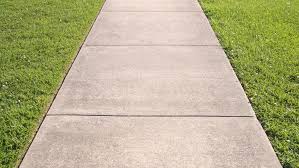Concrete Walkway Repair in Los Angeles

by Alonso Romero
CA State Lic. Concrete & Masonry C-8
CA State Lic. General Contruction - B
Buckaroo Banzai the Concrete Nerd
Actual person performing the job
Date: 12/21/2023
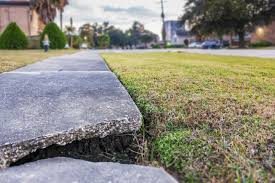
How often has this happened to you? Your arms are full of groceries, you’re just trying to get to the front door and – bam – you hit that broken concrete walkway with your foot. You’re lucky you don’t trip every time you walk from your car to the front door. And don’t even get started with that walkway from the sidewalk to the door. How will the trick-or-treaters not trip?
There is a solution. Replace that old, cracked, accident waiting to happen with a new, durable concrete walkway.
Why is my walkway cracked in Los Angeles?
Concrete is one of the most durable building materials on the planet, when properly installed. Unfortunately, a lot of the concrete we find at our homes were installed without the modern methods of stabilization, including rebar.
Most of the walkways you see around Los Angeles homes are at least 30 to 40 years old, if not older. Remember, most of Los Angeles was built during housing booms in the 1880s, 1920s, and 1940s. Many of our unique homes were built when building codes were far more lax, which can cause problems with the concrete. But there are other forces at work causing these trip hazards.
Tree Roots Crack Concrete Walkways in Los Angeles
While there are many reasons why concrete walkways crack in Los Angeles, the number one reason may surprise you. It isn’t earthquakes. Nope. It’s that beautiful mature tree in your front lawn.
Your foliage (trees, grass, shrubs) are destroying your concrete sidewalks and walkways. But how? It’s all underground. So let’s get to the root of the cause.
As trees (and other foliage) mature, their roots spread out, searching for stability, water and nutrients. As the tree ages, the roots get larger and larger – getting as big as 12 inches in diameter. These roots push up on the concrete, making it crack.
Not only that, but concrete placed 30-40 years ago didn’t have any rebar installed in it, so a root as small as 5 inches in diameter can pop a walkway out of place.
Yes, those luscious ficus trees are wreaking havoc on your concrete walkways.
More Reinforcement in the Walkways
How old do you think the concrete walkways are around your home? If your home dates from the 1920s, your walkway could be that old. Building codes at that time were far more lax. This is part of the reason why Los Angeles has such interesting neighborhoods. Apartments were allowed to be built next to single family homes and bungalow courts.
However, this meant that our concrete walkways were not built to stand the test of time, as they are today. There isn’t enough reinforcement in our concrete, making our concrete more prone to damage. The modern method of installing rebar before pouring concrete creates a more sturdy structure that can withstand those pesky roots trying to bust out of the walkway.
Erosion Under the Concrete Walkway
Have you ever considered what is underneath your walkway? How does it stay put anyway?
When a concrete walkway is installed, it isn’t just poured onto the lawn. First, the contractor will trench the area a few inches before installing rebar and pouring the concrete. If your concrete walkway is older, chances are the area was trenched beforehand, but no rebar was installed.
So think about your lawn for a moment. It probably gets watered every few days. Not to mention our heavy rainy seasons. The soil will absorb only so much water. The rest of it has to go somewhere – and that somewhere could be under your walkway. As the water flows (quickly or slowly) underneath the walkway, it takes with it a little bit of soil. Compound that soil over decades and now you’ve got a pocket of nothing underneath your walkway, meaning it’s going to collapse and crack. And these cracks, when left unattended, just get worse and worse.
Too Few Joints
No, not that kind of joint. Ever walked around your neighborhood? Ever wonder why the sidewalk has that line going across it every couple of feet? In concreteland, we call that a joint.
This kind of joint allows the concrete to “breathe.” You’ll never notice it, but concrete moves quite a bit. You may remember from science class that when materials get hotter, they expand and when they get cooler, they shrink. Okay, you may not remember that from science class, but that’s exactly what happens to your concrete walkway. During our fabulous heatwaves, the concrete expands. If your walkway has joints, the concrete has room to grow. If your walkway doesn’t have joints, sorry. Your concrete is going to crack and buckle under the strain.
That’s why, when you are installing a new walkway, it is imperative to hire a contractor who has a concrete license. That contractor has studied the methodologies involved with concrete and will know where to put the joints and how many to include. No joints? You’re just setting yourself up for another cracked walkway.
Concrete Walkways Dried Too Fast
Watching concrete dry is a little like watching paint dry. Monotonous. But believe it or not, you want concrete to dry at a certain rate to avoid any problems.
Hiring a contractor with a concrete license is crucial to the health of your walkway. They know, for instance, that on hot days (especially during our summers), the soil has to be soaked through the night before the concrete is poured. Why? You don’t want the parched soil to leech the water out of the concrete. That makes the concrete dry too fast, leaving you with brittle and unstable concrete.
Also, after your concrete is poured on hot days, you want to baby it. Water it a couple times a day until it is dry. That will keep the concrete from drying up too fast.
Cracked, Uneven Walkway Repair Contractor in Los Angeles
When we’re talking about walkways, this is very different from sidewalks. Sidewalks are the responsibility of the city of Los Angeles. I know our city sidewalks get a (justifiably) bad rap. In fact, if you are dealing with nasty sidewalks that are not on your property line, look into a city program, Safe Sidewalks LA. The city will give you a rebate for up to $12,000 to replace those buckling, deteriorated sidewalks. However, the biggest caveat to that program is that you MUST use a contractor who has a concrete license. Your standard Class B licensed contractor just won’t cut it. Check out the city’s FAQs to answer even more questions about the rebate process.
Now, let’s get back to walkways that are on your property and let’s get those fixed up. Give us a call for a free quote and you’ll be walking to your front door with no fear.
